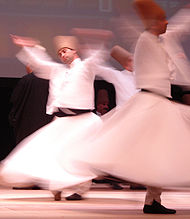
Movements (sacred dances)
Encyclopedia

Sacred dance
Sacred dance encompasses all movement that expresses or enhances spiritual experiences. It may be a part of a worship service, a group experience or a private spiritual practice.Some examples of sacred dance are:* Native American Ghost Dance...
s that were collected or authored by G. I. Gurdjieff
G. I. Gurdjieff
George Ivanovich Gurdjieff according to Gurdjieff's principles and instructions, or the "Fourth Way."At one point he described his teaching as "esoteric Christianity."...
and taught to his students as part of the work of self observation and self study.
Gurdjieff taught that the movements were not merely calisthenics
Calisthenics
Calisthenics are a form of aerobic exercise consisting of a variety of simple, often rhythmical, movements, generally using multiple equipment or apparatus. They are intended to increase body strength and flexibility with movements such as bending, jumping, swinging, twisting or kicking, using...
, exercises in concentration, and displays of bodily coordination and aesthetic sensibility
Aesthetics
Aesthetics is a branch of philosophy dealing with the nature of beauty, art, and taste, and with the creation and appreciation of beauty. It is more scientifically defined as the study of sensory or sensori-emotional values, sometimes called judgments of sentiment and taste...
: on the contrary, in the movements was embedded real, concrete knowledge, passed from generation to generation of initiates - each posture and gesture representing some cosmic truth
Truth
Truth has a variety of meanings, such as the state of being in accord with fact or reality. It can also mean having fidelity to an original or to a standard or ideal. In a common usage, it also means constancy or sincerity in action or character...
that the informed observer could read like a book. Certain of Gurdjieff's followers claim that the Gurdjieff Movements can only be properly transmitted by those who themselves have been initiated in the direct line of Gurdjieff; otherwise, they say, it leads nowhere.
The movements are purportedly based upon traditional dances that Gurdjieff studied as he traveled throughout central Asia
Central Asia
Central Asia is a core region of the Asian continent from the Caspian Sea in the west, China in the east, Afghanistan in the south, and Russia in the north...
, India, Tibet, the Orient and Africa
Africa
Africa is the world's second largest and second most populous continent, after Asia. At about 30.2 million km² including adjacent islands, it covers 6% of the Earth's total surface area and 20.4% of the total land area...
where he encountered various Indo-European and Sufi orders, Buddhist centers and other sources of traditional culture and learning. However, Gurdjieff insists that the main source as well as the unique symbol of the Enneagram
Fourth Way Enneagram
The Fourth Way enneagram is a figure published in 1947 in In Search of the Miraculous by P.D. Ouspensky, and an integral part of the so-called Fourth Way esoteric system associated with George Gurdjieff...
was transmitted to him as an initiate in the Sarmoung Monastery. There were literally thousands of movements collected and taught by Gurdjieff throughout his teaching career. The music for the movements was written by Gurdjieff and Thomas de Hartmann
Thomas de Hartmann
Thomas Alexandrovich de Hartmann September 21, 1885March 28, 1956 was a Russian composer and prominent student and collaborator of George Gurdjieff.-Biography:...
, as well as British composer Edouard Michael.
A brief glimpse of the dances appears at the very end of the motion picture about Gurdjieff, Meetings with Remarkable Men
Meetings with Remarkable Men (film)
Meetings with Remarkable Men is a 1979 British film directed by Peter Brook and based on the book of the same name. Shot on location in Afghanistan , it starred Terence Stamp, and Dragan Maksimovic as the adult G. I. Gurdjieff...
, produced and directed in 1978 by Peter Brook
Peter Brook
Peter Stephen Paul Brook CH, CBE is an English theatre and film director and innovator, who has been based in France since the early 1970s.-Life:...
.
An example of Gurdjieff's later series of movements (The 39 series) are:
- 1. The Automat.
- 2. Prayer in Three Parts.
- 3. Four Tableaux.
- 4. Prayer for Instruction.
- 5. Pointing Dervish.
- 6. Movement in canon
- 7. Esoteric
- 8. Triads in Pairs. Complexity in Simplicity.
- 9. 'Olbogmek'. Double Multiplication
- 10. (A light dance with counting in canon)
- 11. Lord Have Mercy.
- 12. Halleluia
- 13. (A prayer movement)
- 14. Reading from a Sacred Book
- 15. (Tibetan) Days of the Week.
- 16. -- 17. Multiplication of Enneagram
- 18. -- 19. Stop Exercise. 'Frightened'
- 20. Six Displacements. Dervish exercise.
- 21. Remorse of Conscience
- 22. of Mesoteric series
- 23. -- 24. Chadze Vadze (Lord, Mercy!)
- 25. Black and White Magic.
- 26. (A multiplication)
- 27. (A canon)
- 28. -- 29. -- 30. Canon of Six Measures. A 'cosmic' dance.
- 31. Fifteen Rythmns. Getting up and Down
- 32. Automaton.
- 33. Premier exercise apri le retour d'Amerique
- 34. (A continuous multiplication)
- 35. -- 36. DervishDervishA Dervish or Darvesh is someone treading a Sufi Muslim ascetic path or "Tariqah", known for their extreme poverty and austerity, similar to mendicant friars in Christianity or Hindu/Buddhist/Jain sadhus.-Etymology:The Persian word darvīsh is of ancient origin and descends from a Proto-Iranian...
Movement. People scattered about - 37. -- 38. (A canon)
- 39. (Thinking, Feeling, Sensing)
External links
http://www.4thway.eu authentic GGURDJIEFF' teaching- Gurdjieff Heritage Society resource regarding Gurdjieff Movements and music
- Gurdjieff Movements
- The Fourth Way Archive
- A Demonstration of Gurdjieff Sacred Dances
- GurdjieffArabic.Org نشرة عربية عن تعاليم جورج إ. غوردجييف

